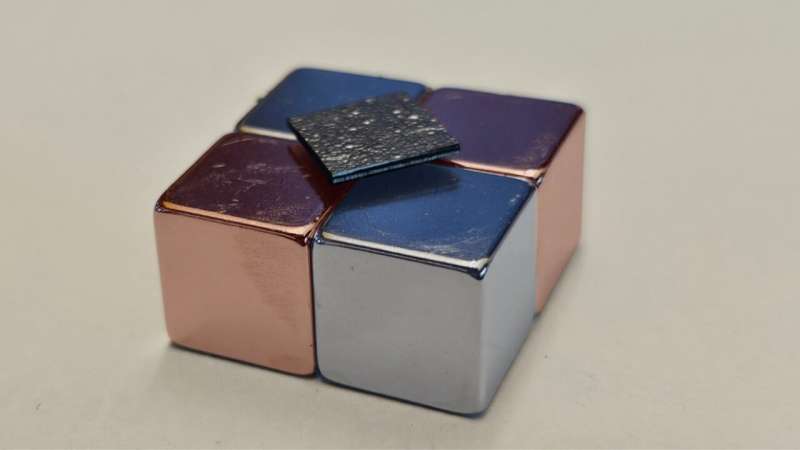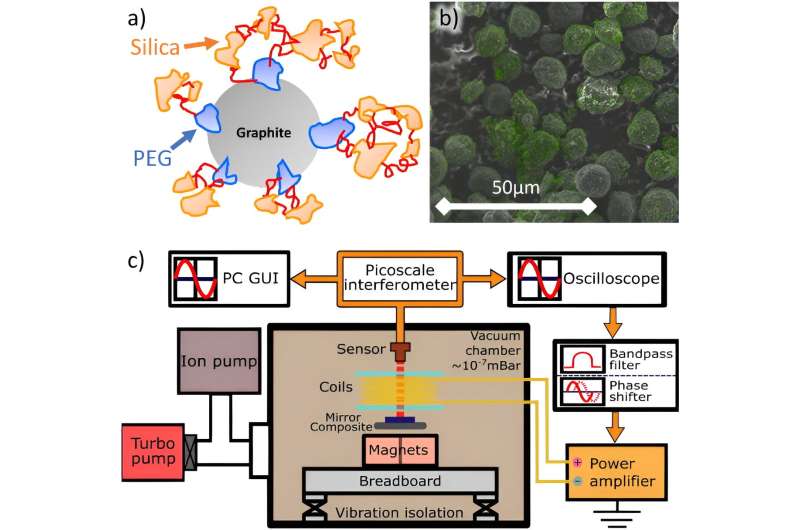This article has been reviewed according to Science X's editorial process and policies. Editors have highlighted the following attributes while ensuring the content's credibility:
fact-checked
peer-reviewed publication
trusted source
proofread
Magnetic levitation: New material offers potential for unlocking gravity-free technology

Researchers at the Quantum Machines Unit at the Okinawa Institute of Science and Technology (OIST) are studying levitating materials—substances that can remain suspended in a stable position without any physical contact or mechanical support.
The most common type of levitation occurs through magnetic fields. Objects such as superconductors or diamagnetic materials (materials repelled by a magnetic field) can be made to float above magnets to develop advanced sensors for various scientific and everyday uses.
Prof. Jason Twamley, head of the unit, and his team of OIST researchers and international collaborators have designed a floating platform within a vacuum using graphite and magnets. Remarkably, this levitating platform operates without relying on external power sources and can assist in the development of ultra-sensitive sensors for highly precise and efficient measurements. Their results have been published in the journal Applied Physics Letters.
When an external magnetic field is applied to 'diamagnetic' materials, these materials generate a magnetic field in the opposite direction, resulting in a repulsive force—they push away from the field. Therefore, objects made of diamagnetic materials can float above strong magnetic fields. For instance, in maglev trains, powerful superconducting magnets create a strong magnetic field with diamagnetic materials to achieve levitation, seemingly defying gravity.
Graphite, the crystalline form of carbon found in pencils, is strongly repelled by magnets (highly diamagnetic). By chemically coating a powder of microscopic graphite beads with silica and mixing the coated powder in wax, the researchers formed a centimeter-sized thin square plate that hovers above magnets arranged in a grid pattern.
Creating a floating platform that requires no external power has several challenges. The biggest limiting factor is 'eddy damping', which occurs when an oscillating system loses energy over time because of external forces. When an electrical conductor, like graphite, passes through a powerful magnetic field, it experiences energy loss due to the flow of electrical currents. This energy loss has discouraged the use of magnetic levitation to develop advanced sensors.
OIST scientists set out to engineer a platform that can float and oscillate without losing energy—meaning that once set in motion, it will continue oscillating for an extended period, even without additional energy input. This type of 'frictionless' platform could have many applications, including new types of sensors for measuring force, acceleration, and gravity.
However, even if scientists manage to decrease eddy damping, there is another challenge: minimizing the kinetic energy of the oscillating platform. Lowering this energy level is important for two reasons. First, it makes the platform more sensitive for use as a sensor.
Second, cooling its motion toward the quantum regime (where quantum effects dominate) could open new possibilities for precision measurements. Therefore, to achieve a truly frictionless, self-sustaining floating platform, both eddy damping and kinetic energy challenges need to be solved.
To address these, the researchers focused on creating a new material derived from graphite. By chemically changing it, they transformed graphite into an electrical insulator. This change stops energy losses while allowing the material to levitate in a vacuum.

In their experimental setup, the scientists continuously monitored the platform's motion. Using this real-time information, they applied a feedback magnetic force to dampen the platform's motion—essentially cooling down its movement and slowing it down significantly.
"Heat causes motion, but by continuously monitoring and providing real-time feedback in the form of corrective actions to the system, we can decrease this movement. The feedback adjusts the system's damping rate, which is how quickly it loses energy, so by actively controlling the damping, we reduce the system's kinetic energy, effectively cooling it down," Prof. Twamley explained.
"If cooled sufficiently, our levitating platform could outperform even the most sensitive atomic gravimeters developed to date. These are cutting-edge instruments that use the behavior of atoms to precisely measure gravity. Achieving this level of precision requires rigorous engineering to isolate the platform from external disturbances such as vibrations, magnetic fields, and electrical noise. Our ongoing work focuses on refining these systems to unlock the full potential of this technology."
Prof. Twamley's unit focuses on using levitating materials to build mechanical oscillators—systems that have repetitive or periodic motion around a central point. These oscillations occur in various contexts, such as pendulums, masses connected to springs, and acoustic systems.
This research opens exciting possibilities for ultra-sensitive sensors and achieving precise control over oscillating platforms. By combining levitation, insulation, and real-time feedback, Prof. Twamley's team is pushing the boundaries of what is achievable in materials science and sensor technology.
More information: S. Tian et al, Feedback cooling of an insulating high-Q diamagnetically levitated plate, Applied Physics Letters (2024). DOI: 10.1063/5.0189219
Journal information: Applied Physics Letters
Provided by Okinawa Institute of Science and Technology





















